Handicrafts of Kerman: The Fine Art of Desert Dwellers ( kerman iran )
Kerman is one of the popular provinces for enthusiasts of radiant sunshine and warm desert sands. This province boasts numerous attractions, each of which holds significant historical or natural value. The Lut Desert, Meymand Village, Vakil Bazaar, Gonbad-e Jabaliye, Arg-e Bam, Meymand Rocky Village, Rayen Citadel, Coin Museum, Shah Nematollah Vali Shrine, and more are among the remarkable places to visit in Kerman that we highly recommend including in your itinerary. While visiting tourist attractions constitutes an essential part of the journey, it is not everything. Typically, towards the end of their travel days, travelers rush to purchase souvenirs and handicrafts of Kerman as gifts for their friends and family.
Kerman’s souvenirs include various sweets and agricultural products, the preparation of which does not incur significant costs. However, if you are looking for a more expensive and enduring gift, Kerman’s handicrafts are a better option.
1.Kerman Carpet
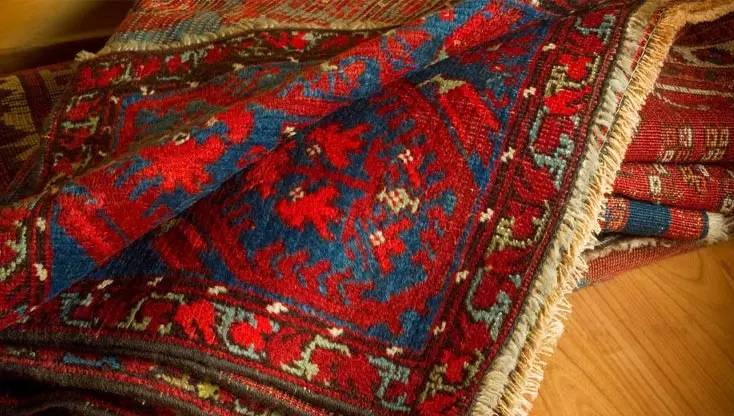
In praising Kerman carpets, there is a famous proverb that goes: “So-and-so remains as durable as a Kerman carpet and becomes younger as time passes.” This proverb signifies that Kerman carpets retain their value no matter how much they are used and always remain precious. The history of Kerman carpets does not date back to just a day or two but rather is a remnant of the Safavid era during Kerman’s heyday.
The diversity of colors, delicacy, and intricacy of patterns used in Kerman carpets are truly remarkable. Since high-quality natural dyes are used in their fabrication, these carpets have excellent durability and quality.
2.Afshari Rug
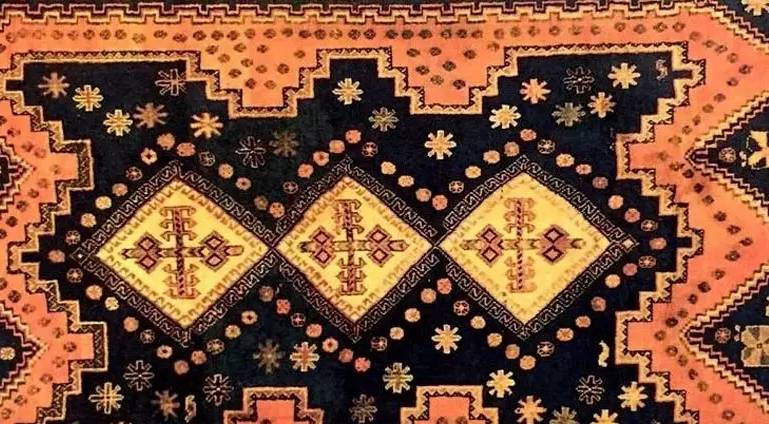
Afshari rugs or carpets are among the most popular tribal rugs in Iran with worldwide renown. These rugs are often woven by the Afshar tribe, which includes cities such as Babak, Sirjan, Baft, Rabar, and Jiroft. Afshari rugs are considered one of the most important handicrafts of Kerman and feature eleven different designs including Hashmat flower, cloud pattern, dual Golpari, three-headed design, pulpit design, Mousa Khani, jungle, etc. These rugs abundantly utilize colors such as crimson, brown, cream, black, and indigo in their weaving.
3.Shiriki Pich Kilim
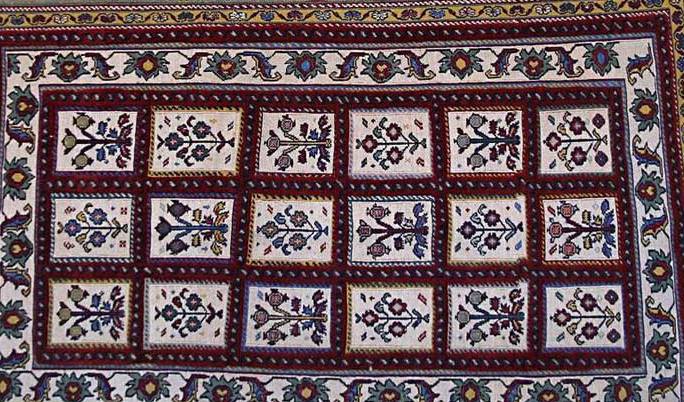
Kilim weaving is an ancient art in Kerman, and historians attribute its antiquity to the Afshar and Safavid periods, when the Bozchāqchī and Afshar tribes entered Kerman. Shiriki Pich (Shiriki Pich) Kilim of Sirjan is considered one of the famous and unique kilims in terms of weaving and design because this kilim is a combination of kilim and carpet, and its wefts do not have a role in its texture; only the warps shape its final form. Sirjan and the village of Daristan, which has been registered as the Kilim Village by UNESCO, are considered the main center and pole of this precious art.
4.Kerman Embroidery
Kerman embroidery is considered one of the prominent handicrafts and one of the most famous handicrafts of Kerman, created by the hands of talented women in the city. To create this art, a fabric called “Ariz” or “Ris” (colored woolen threads) is needed, and of course, a bit of taste and creativity of the women and girls of the city to implement their mental designs or ancient patterns. This art has been prevalent in Iran since the Safavid era and is considered one of the oldest embroidery techniques in the country.
5.Gabbeh Weaving of Kerman
Gabbeh weaving, also known as Zoroastrian embroidery, is an art created by Zoroastrian Iranian artists and has had influences on European, Japanese, and Chinese art during the Sassanian era. In the past, Gabbeh fabrics were used for bridal attire and girls’ clothing. In this art, very delicate patterns of peacocks, trees, and flowers are embroidered on the fabric using silk threads. The intricacy of Kerman Gabbeh weavings is such that the stitches are barely visible without a magnifying glass.
6.Ariz Weaving of Kerman
Ariz weaving is an art that is on the verge of extinction, in which a type of thick woolen fabric is produced. This fabric, which is often used as the underlying fabric for embroidery, was also used in the past for coats and jackets. In the not-so-distant past, this art was completely done by wooden weaving machines, but today automatic machines have replaced these machines, and their output lacks the delicacy and quality of previous designs.
7.Shawl Weaving of Kerman
The art of shawl weaving in this city has a longer history than carpet weaving, with the adaptation of ancient carpet designs from the designs used in the shawls of this region as evidence of this claim. Among the weaving arts, this art has been widely practiced in Kerman from the past to the present, and the demand of buyers and fans of Kerman shawls has spurred people’s engagement in shawl weaving. Various designs such as Lajvardi, Buta, Lucky, Deer Horn, Ahrami, Termeh, and Zangari are offered in Kerman shawl shops, often woven in dimensions of three meters.
8.Khorjin Weaving of Kerman
In the past, the use of khorjins on pack animals and bicycles was common, but today it has few enthusiasts. Some nomads and villagers of this province still weave khorjins with symmetrical patterns using cotton and wool threads. It should be noted that these bags are still used as one of the items in the bride’s dowry or as a place to store valuables among nomads.
9.Kermani Copper Utensils
In addition to their utility, the dazzling elegance of copper utensils has always adorned Iranian homes and kitchens. Kermani copper utensils are highly valued for their quality and durability because the city is home to large copper mines. Experienced coppersmiths of Kerman have contributed such an art to the production of copper utensils and decorative objects that it is unlikely you will leave their market empty-handed.
10.Ajideh Embroidery of Kerman
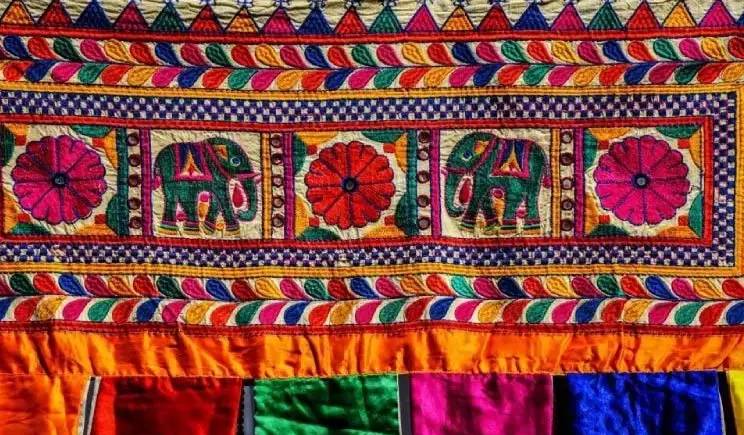
Ajideh embroidery, also known as layered or cotton embroidery, is recognized by other names that have a direct connection to the way this art is sewn. In Ajideh embroidery, a layer of cotton is placed between two fabrics, and then talented Kermani artists patiently and meticulously sew prominent and beautifully patterned designs on the fabric.
11.Mefroshu of Kerman
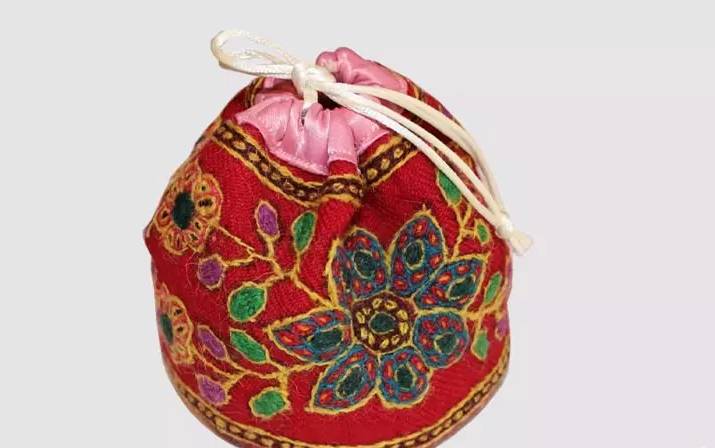
Mefroshu, pronounced as Mefshu, is a type of beautifully decorated bag that is now produced in a more modern form and used by young women as a purse. This bag, made from a circular fabric lined with lining, is embroidered around the circumference and a cord is passed through it. The decorations on the bag are the most fascinating part of the story, as everyone mentally designs their desired pattern on it. In the past, this bag had various uses such as storing granulated sugar, herbal medicines, and sewing and embroidery tools such as thread and needles.
12.Wood Carving of Kerman

Wood carving and fretwork are considered highly ancient arts in Kerman. By wandering through the markets of Kerman, you can find intricate and artistic designs to purchase as souvenirs.
13.Sisal Weaving of Kerman
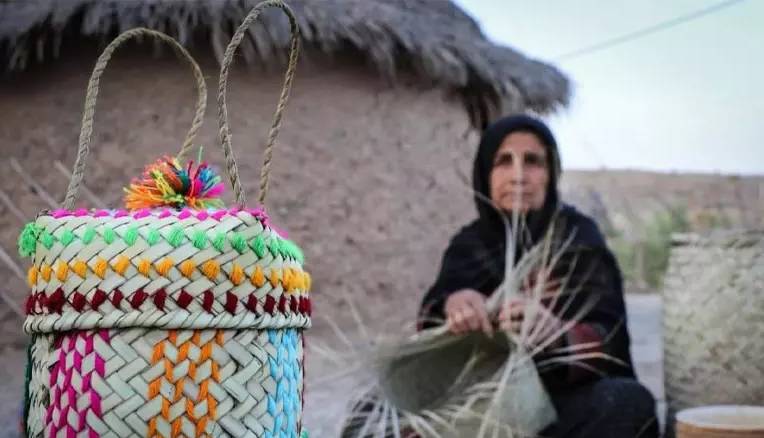
The presence of expansive palm groves in the province of Kerman has provided a good opportunity for the emergence of the art of sisal weaving. In this art, palm fiber is used for weaving sandals, decorative objects, and ropes.
14.Kermani Straw Weaving
Kermani straw weavers intertwine strands of plant fibers to create one of the most beautiful handicrafts of Kerman. Although straw weaving is often associated with northern regions of the country, this art has much to offer in the city of Kerman as well, where it is used for weaving hats, baskets, and various containers.
15.Termeh of Kerman
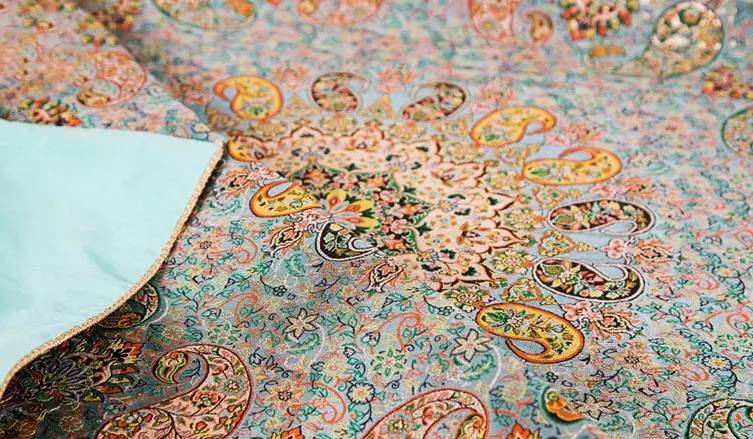
Termeh is a delicate and expensive fabric woven with very fine fibers in patterns of Shah Abbasi flowers and botteh motifs, which is offered in various cities of Iran, including Yazd. Kermani artisans also have expertise in termeh weaving, and you can find the most exquisite termehs by visiting Kermani markets.
16.Musical Instrument Making in Kerman

The crafting of various instruments such as violins, tar, santoor, etc., is one of the shining handicrafts of the Kerman province, carried out by experienced artisans of the city. Masters like Hossein Masoud have gained great skill and fame in instrument making. For purchasing handmade and high-quality instruments, you can visit the workshops of instrument making in Kerman.
So far, we have introduced some of the most famous souvenirs of Kerman. In addition to the mentioned items, other types of handicrafts such as jajim weaving, wood lattice work, wood marquetry, wood lattice, precious pen work, and products like knives, anvils, and sugar crushers are also known as valuable souvenirs of this province.
Among other arts and crafts of Kerman, sisal weaving, Esfand embroidery, agate engraving, Rafsanjan tiles and ceramics, traditional hats and softo, khoush embroidery, and knife-making in Rayen are considered popular arts of Kerman.
Staying in Kerman
When you enter this province, you will be faced with a plethora of attractions such as the Ganjali Khan Complex and the Prince Mahan Garden. Plan your trip in a way that you do not miss any of the important attractions of this historical city. We recommend not to postpone buying souvenirs and handicrafts of Kerman until the last moments of your trip, as you may not be able to buy your desired souvenirs and gifts due to lack of sufficient time and regret it later.
Final Words
Exploring the vibrant shops of every city and buying souvenirs and handicrafts is considered one of the enjoyable activities of any trip, which has a deep connection with the art and culture of indigenous people. Kerman province, due to its rich cultural and artistic heritage and production of high-quality products, is known as an unparalleled destination for buying memorabilia and souvenirs. In this article, we have endeavored to introduce the most famous handicrafts of Kerman to make the decision-making process and purchasing easier for you.
Frequently Asked Questions
What are the most famous handicrafts of Kerman?
Kermani carpets, Afshari rugs, Shiriki-Pich Kilims, Patteh embroidery, Gabbeh weaving, Arisheh weaving, shawl weaving, Khourjin, Kermani copper vessels, Ajideh embroidery, Mofresho, wood carving, sisal weaving, and more.








